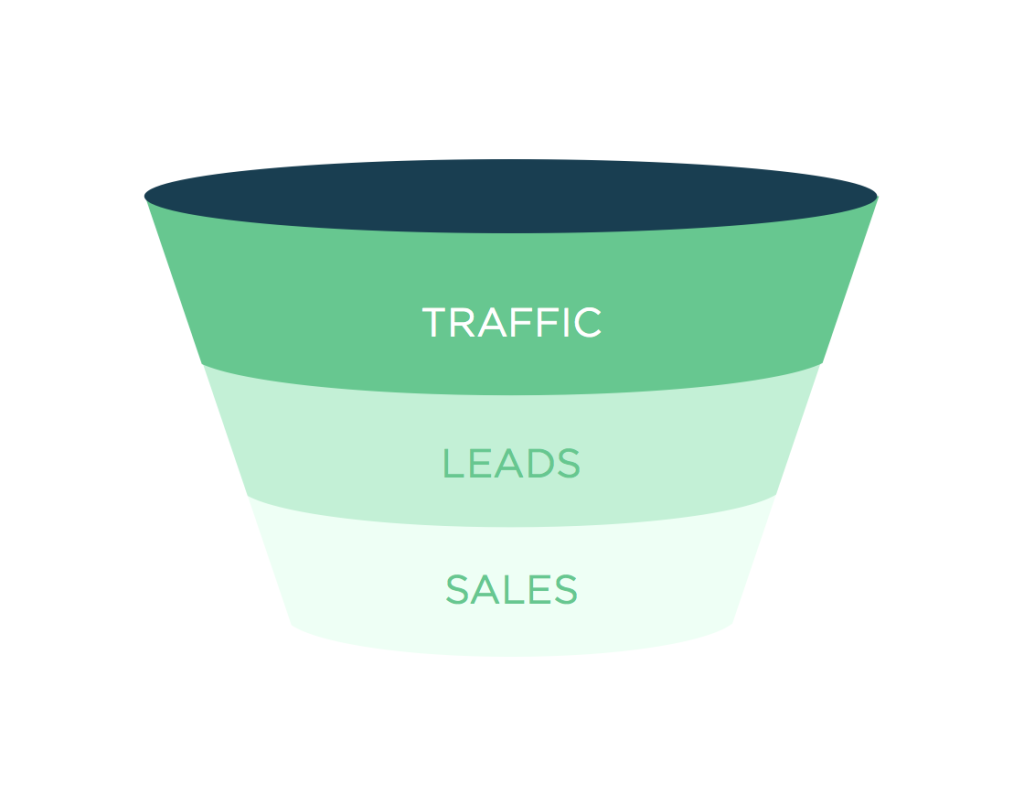This is part of our series on hub & spoke content marketing. Begin here: Executing The Hub & Spoke Content Marketing Strategy
Like every business leader, you want sales.
Content, social, paid ads… You don’t use these tactics because they’re fun. You use them to get sales. If a tactic creates sales, you invest more into it. If it doesn’t create sales, you abandon it.
Before you start dumping money into any marketing tactic, you need an understanding of how people interact with your business, and how you can turn as many of them as possible into customers.
That process is called a marketing funnel.
“Every business has a [marketing] funnel,” says Audience Ops founder Brian Casel. “Whether you’ve intentionally built one out and optimized every level is an open question that you’ll face continuously through the life of your business.”
The hub and spoke content system fits nicely into your marketing funnel, but we’ll get to that in a moment.
First, Let’s Talk About Your Marketing Funnel

Wouldn’t it be great if everyone who visited your website became a customer? If that were the case, you would be a popular case study on conversion optimization, but it never happens like that.
A marketing funnel is a visual representation of how prospective customers interact with your organization. It explains their “path” through your business, from their initial awareness up until they purchase your product. (In rare cases, businesses take their funnel a further step and try to turn customers in evangelists, but that’s a topic for another article.)
A funnel is wider at the top than it is at its bottom. Many people will enter the funnel’s top. This is your total traffic.
As they learn about their problem, your solutions, and the details of your business, they will “travel” down the funnel. At the end, fewer people will exit the funnel than entered. That is, a percentage will buy your product while others abandon your website.
A basic funnel has three stages:
1. Traffic
Quite simply, traffic is the number of people who visit your website. If you stuff more people into the top of the funnel, more people will become customers.
Not all traffic is equal, however. If you sell an enterprise B2B product, getting a million page views would be a big deal… Unless they came from a link posted on an unrelated website, like a mommy blog, cosplay forum, or recipe Instagram account. Those audiences probably don’t match yours. The traffic won’t covert, but your web host will be sure to charge you for it!
Traffic can come from a lot of places: blog content, webinars, social media posts, press releases, forum/Quora comments, paid ads, and countless other places.
Many marketers make the mistake of obsessing over traffic. They implement all sorts of strategies to send more people to their website, but they neglect the next two stages of their funnel.
2. Leads
It’s possible to convince people to buy right on your website (the Holy Grail of customer acquisition cost reduction), but that’s a challenge in a B2B industry. Most people need a bit more convincing. At first they aren’t sure that their problem needs a paid solution, that your tool can provide it, or that you’re trustworthy enough to take their money. Those are all fair points.
So if they won’t buy, you have to give them an option that requires less commitment. You’ve got to capture their attention without asking for cash.
You can do this through an email list. Once you have their email, they move a little lower in your funnel and become a lead. Over time, you should continue to nurture those leads by sending content straight to their inboxes. This messaging should move subscribers closer toward making a decision by educating them about the topic and presenting your product as the logical solution.
3. Sales
Making a sale isn’t as simple as waiting for leads to contact you. Some sales happen that way, sure, but it’s smarter to be more aggressive by qualifying (or scoring) your leads and reaching out directly.
For instance, let’s say you email your subscribers a link to a demonstration of your product. If someone were interested in your product, they would click that link. This person is a warmer lead.
You could either email each person directly when they click that link, or segment that subscriber and send them an automated sequence to send a “personal” email when the link is clicked.
Another way to qualify leads is to request more information based on your ideal customer. For example, you could offer a webinar to your subscribers. On the webinar registration page, you would ask for their title and company size. If your ideal customer is C-level executives from companies of 50+ people, you would now have a database of information to identify warm leads.
The Hub & Spoke Content Strategy and Your Funnel

So where does the hub and spoke system fit into your sales funnel? Like the rest of your content, the primary goal of your hub landing page and spoke articles is to collect traffic and leads.
Traffic will find your hub landing page and spoke articles in three ways:
- Through Google searches. Your keyword choices for each page should be deliberate and your linking structure should be robust, which makes this system appealing to search engines.
- Links from other people. This content format is highly sharable.
- Through bookmarks. The comprehensiveness of the hub landing page makes people more likely to bookmark it as a reference than other pages.
Once traffic visits your hub landing page, they’ll be presented with enough content to introduce them to the topic and a list of links to the spoke articles. Some will abandon your website, but most will click into a spoke article.
That one click into an article doesn’t seem like much, but it starts to build emotional investment with your brand. They have begun a journey through a package of content. They are more likely to take additional actions (like viewing more pages or subscribing) because you’ve coerced them to take that first step.
Your spoke articles are similar to traditional blog posts, but better. These should not be 500 word “McPosts” with surface content and “six quick tips.” You have to create something meaningful if you expect your audience to respond.
Read more here: How to Plan Quality, Lead-Generating Hub & Spoke Articles.
Most importantly, your posts need to include lead magnets to capture subscribers. We recommend creating a content upgrade for every post and using some sort of site-wide lead magnet, like an email course or eBook. If you’ve created a hub and spoke content system before (or you have enough content to whip one up), you could repackage it as a lead magnet.
As you create content for hub and spoke content packages, use this material to nurture your email lists. If they liked one hub enough to sign up, they’ll probably like others.
Wait! Does the hub & spoke system affect the sales end of the funnel?
For the most part, no. The majority of the hub and spoke content strategy’s heavy lifting comes from attracting traffic, capturing leads, and nurturing subscribers. Once people are on your email list, you’ll need other tactics to qualify those leads and pitch them your product.
However, there’s one way to use the hub and spoke system to support your sales efforts.
Create a hub and spoke package on a topic that educates about your product. Unlike most of your content which should be education-based, this topic should be sales-focused. It should explain the benefits of your product and how it can be used.
This sales-focused package could serve as a qualifier for your leads. Send traffic to the hub landing page or individual spoke articles to determine which subscribers are likely to convert into sales. Whoever visits these pages should be tagged as warm leads or moved to email sequences with more aggressive sales content.
This sales-focused hub and spoke package won’t receive much spontaneous web traffic (from Google searches or links), but the cohesive structure still encourages browsing. Since you’ll be sending people to the spoke articles directly (bypassing the hub), add a navigation section of links at the end of each article so readers know that piece is part of a larger set.
Going Forward
Marketing funnels can be as simple or advanced as you need them to be. It’s not uncommon for websites to have dozens of points of entry into their funnels, or multiple funnels that serve different purposes. You’ll see improvements to the traffic and leads levels of your funnel if you implement the hub and spoke content marketing system.
Managing all of your content isn’t easy, especially when you start mixing blog posts with newsletters and social media plugs. The Audience Ops Calendar simplifies the entire process. Check it out